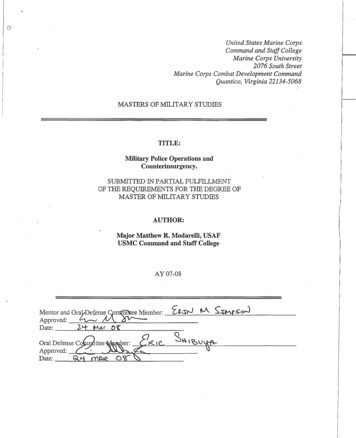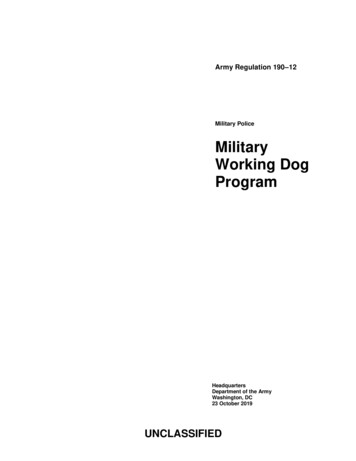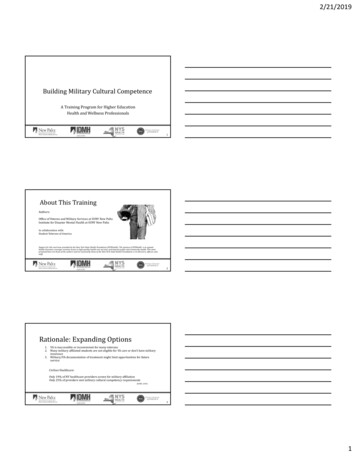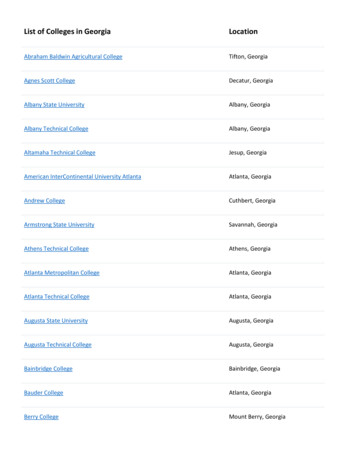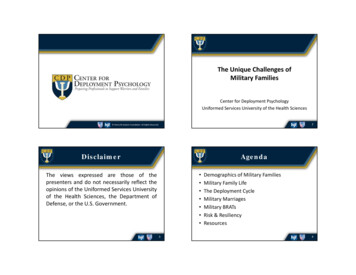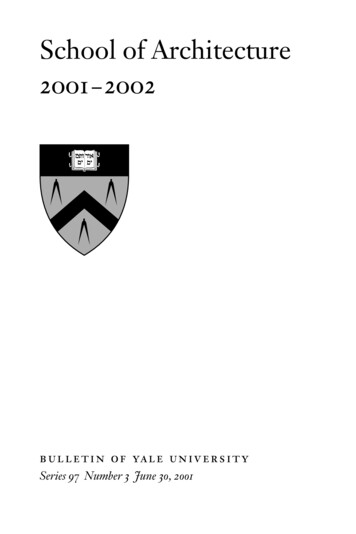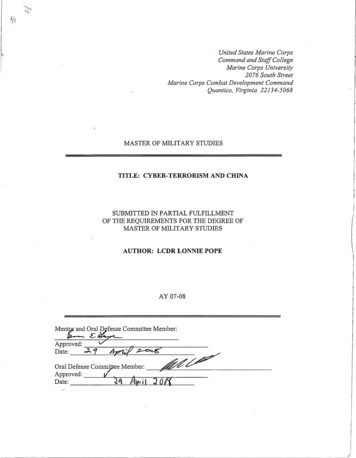
Transcription
United States Marine CorpsCommand and Staff CollegeMarine Corps University2076 South StreetMarine Corps Combat Development CommandQuantico, Virginia 22134-5068MASTER OF MILITARY STUDIESTITLE: CYBER-TERRORISM AND CHINASUBMITTED IN PARTIAL FULFILLMENTOF THE REQUIREMENTS FOR THE DEGREE OFMASTER OF MILITARY STUDIESAUTHOR: LCDR LONNIE POPEAY 07-08Men l Committee Member:Approved:Date:.;1.1Alii , Oral De.fense commre Member:Approved:Date:.:1A A ri I "J {J f/
REPORT DOCUMENTATION PAGEFORM APPROVED - - - OMS NO. 0704-0188rum.le RF.PORTINQ BURDEN FOR TlU5 COI.LECTION Of INFORM,\TION IS rn'ITIMATEDTO AYF.RAOF. IIiOUR PER R :SPON5 :'INCI.UDINOTIlE TIME FOR RF.VIEWINO INSTRUCTIONS,SF.ARCIIINO EXISTING D,\1,\ sOUReF.s. DATIIERINO Al'l'D M/\INT.\ININOTHE DAT,\ NEEDED. ANDCOMPI.FoTINO AND REVIEWING TilE COI.I.F.CTloN Of' INFORM,\TION. SEND COMMF.l'.'TS REGARDING TillS BURDEN FR'ITIf-It\TF. OR ,\NY GTllF.R ASPF.C'fOf'TIIIS COI.!.t:CTION m"INFORMATION.INCI.IJDINOSlJOOfR'InONS FOR REDUCINQTIIIS DURDEN. TO \Y.\liIllNOTONIIF.ADQUARTF.RS SERVICf'.'I. D1RECTOR,\TF. FOR INFORM,\TION OPER,\TIONS AND REPORTS, 121S JF.FFF.RSUN 0,\\,15 IIIOIIWI\\', SIJITI 1204. ARI.INOTON. VA 22202-'1302. AND TO TIIF. OFF/CI; Of' M,\NAOF.MF.NT AND I'lUDOET,I't\PERWORK Rr.DUCTION I'ROJf,CT(0704·ol1111)WASIIINOTON, DC 105031. AGENCY USE ONLY (LEAVE BLANK)12. REPORT DATE3. REPORT TYPE AND DATES COVEREDSTUDENT RESEARCH PAPER5. FUNDING NUMBERS4. TITLE AND SUBTITLECyber-Terrorism and ChinaNIA6. AUTHOR(S)LDCR Lonnie Pope7. PERFORMING ORGANIZATION NAME(S) AND ADDRESS(ES)USMC COMMAND AND STAFF COLLEGE2076 SOUTH STREET, MCCDC, QUANTICO, VA 22134-50689. SPONSORING/MONITORING AGENCY NAME(S) AND ADDRESS(ES)8. PERFORMING ORGANIZATION REPORT NUMBERNONE10. SPONSORING/MONITORING AGENCY REPORT NUMBER:NONESAME AS #7.11. SUPPLEMENTARY NOTESNONE12B. DISTRIBUTION CODE12A. DISTRIBUTION/AVAILABILITY STATEMENTNIANO RESTRICTIONSABSTRACT (MAXIMUM 200 WORDS)In today's society where nations continue to embrace the use of computers and technology, has resulted inweaknesses that can be exploited through cyber-terrorism. All computer systems from the personal computer,to corporate banking systems, as well as governmental and military systems are vulnerable to attack. However,the critical focus that could most effect a country like the United States are the SCADA systems that controlcritical infrastructures. A country or terrorist organization may not have the ability to attack the U.S. directly,but can severely cripple the U.S through these systems.14. SUBJECT TERMS (KEY WORDS ON WHICH TO PERFORM SEARCH)Cyber-attack, Cyber-terrorism, China, Infrastructure,SCADA systems.17. SECURITY CLASSIFICATION OF REPORTUNCLASSIFIED15. NUMBER OF PAGES:3516. PRICE CODE: N/A18. SECURITYCLASSIFICATION OFTHIS PAGE:19. SECURITYCLASSIFICATION OFABSTRACTUNCLASSIFIEDUNCLASSIFIED20. LIMITATION OF ABSTRACT
[f)iiExecutive SummaryTitle: Cyber-Terrorism and ChinaAuthor: LCDR Lonnie M. Pope, United States NavyThesis: To assess the possibility of a cyber-terrorism attack using China to explore howsuch an attack could affect the United States' military and U.S. civilian infrastructure.Discussion: In today's society where nations continue to embrace the use of computersand technology, has resulted in weaknesses that can be exploited through cyber-terrorism.All computer systems from the personal computer, to corporate banking systems, as wellas governmental and military systems are vulnerable to attack. However, the criticalfocus that could most effect a country like the United States are the SCADA systems thatcontrol critical infrastructures. A country or terrorist organization may not have theability to attack the U.S. directly, but can severely cripple the U.S through these systems.Also, cyber-attacks are potent tools for intelligence gathering and can be a forcemultiplier in military operations as a strategic weapon. This paper will use China and itscyber-warfare capabilities to describe and depict the issues and concerns regarding cyberterrorism. The next war may never see actual armies join to fight each other in battle buta war where persons on computers are able to defeat a superpower.!Conclusion: Cyber-warfare is the battleground of the future and must be taken seriously.As previously discussed, this form of warfare does not require the need to fight "managainst man," yet it will certainly have a much greater affect on the United States thanany other form of war previously fought. There must be a concerted effort to updatecurrent infrastructure and to train the U.S. military in methods of fighting this new formof warfare. When evaluating the threat to the United States concerning cyber-warfare:the greatest threat may not be to the U.S. military or its war fighting capabilities but tothe United States' civilian infrastructure and its survival as a superpowe .r
iiiDISCLAIMERTHE OPINIONS AND CONCLUSIONS EXPRESSED HEREIN ARE THOSE OF THEINDIVIDUAL STUDENT AUTHOR AND DO NOT NECESSARILY REPRESENTTHE VIEWS OF EITHER THE MARINE CORPS COMMAND AND STAFFCOLLEGE OR ANY OTHER GOVERNMENTAL AGENCY. REFERENCES TOTHIS STUDY SHOULD INCLUDE THE FOREGOING STATEMENT.QUOTATION FROM, ABSTRACTION FROM, OR REPRODUCTION OF ALL ORANY PART OF THIS DOCUMENT IS PERMITTED PROVIDED PROPERACKNOWLEDGEMENT IS MADE.
ivTable of YBER-TERRORISMINFRASTRUCTURETYPES OF ATTACKISSUESVULNERABILITYCYBER-ATTACK: MILITARY OPERATIONS.CHINACHINA INFORMATION OPERATIONSTHE PEOPLES LIBERATION ARMyCHINESE CYBER-ATTACKSCHINA'S WARFARE PHILOSOPHyCONCLUSIONCITATIONS AND END NOTESBIBLIOGRAPHy123679101214: 161718192125
vACKNOWLEGMENTSI would like to take the time to thank the staff of the Grey Research Center for their helpin this endeavor. The guidance and assistance received was extremely helpful. I wouldspecifically like to recognize: Rachel Kingcade and Andrea Hamlen for their time andeffort.
·Cyber-Terrorism and ChinaThe history of modern China began on October 10, 1911, when the Chinesepeople overthrew the ancient Chinese Empire, and established a republic.] One of thelargest and most significant wars of the 20th century was the Chinese Civil War of 19301949. This civil war was fought between the armies of the Nationalist government ofChina led by President Jiang Jieshi (Chiang Kai-shek) and Communist armies under theleadership of Chinese Communist Party (CCP) headed by Chairman Mao Zedong (MaoTse-tung). The change from an empire to a republic resulted in a radical new direction ineconomic, political, and social development for China. Externally, the result was a major.alteration of world power bloc equations and new challenges for U.S. policymakers. 2Since 1949, China as a Communist Nation has done what no other CommunistNation has been able to do: It has successfully maintained its Maoist Communist idealswhile establishing itself as a world power. Its culture and political system has been ableto adapt and to thrive in the realm of an opposing world-view. Within the last fifty-nineyears, China has come of age; however, it has had to overcome many of its scientific andtechnological short falls with regard to the United States by irregular means.This thesis will focus on an ever-increasing issue of concern for the United States:Cyber-terrorism on behalf of China. According to the U.S. Federal Bureau ofInvestigation (FBI), cyber-terrorism is any "premeditated, politically motivated attackagainst information, computer systems, computer programs, and data which results inviolence against non-combatant targets by sub-national groups or clandestine agents."Unlike a nuisance virus or computer attack that results in a denial of service, a cyber-
2terrorist attack is designed to cause physical violence or extreme financial harm. 3 Thisstudy will assess the possibility of a cyber-terrorism attack and will use China as anexample to explore how such an attack could affect the United States' military and U.S.civilian infrastructure.Although this study will focus on China and why it has resorted to cyberterrorism, it is meant to be a realistic threat assessment concerning the national securityof the United States. Each of the topics to be discussed has played, and will continue toplay an extensive role concerning how China looks to the United States as a military andeconomic enemy. Only Chinese capabilities that have been reported within governmentagencies, academia, and the media will be presented. However, all cyber-terrorismtactics discussed will be within the capability of Chinese military.Cyber-Terrorism:Cyber-terrorism can be conducted on many different levels. An attack could be assimple as one person on a computer against another or a governmental agency attackinganother government. Such sources or targets of attack are not limited to just the personalPC, but may include computer hardware from routers and switches to systems control and .data acquisition (SCADA) systems.This study will focus on China's use of cyber-terrorism to conduct militaryoperations and threaten the United States' national security. When looking at cyberterrorism there needs to be an internal focus as to what may be gained by an attack inorder to know what and how to defend against that attack. Intelligence obtained by aforeign entity may be crucial in future planning, which could involve limited,
3conventional, nuclear, and strategic planning against our country. Cyber-terrorism hasbecome the easiest and most effective method of gathering intelligence in the modernera. 4 Communications, computer systems, intelligence, surveillance and reconnaissancesystems vulnerabilities, because of cyber-terrorism have become a force multiplier for anenemy. The ability to gain access to these systems allows an enemy the ability to planand execute strategic targeting of their enemies vital infrastructures.Infrastructure:The automation--- or cybernation---ofthe infrastructure has come about largelybecause it offers unmistakable economic and performance benefits. As a result, however,the United States has become a wired nation, with implications that are still not fullyunderstood. 5Three current trends raise concerns about the reliability of the United States'automated infrastructure: Infrastructure services are becoming increasingly dependent on complexinformation networks that are potentially vulnerable to failure ordisruption. The business environment is changing with deregulation, downsizing,increasing competition, and the entry of new companies into the marketto provide for infrastructure services. Infrastructure information networks are potentially becoming moreaccessible even as computer intrusions, which are already quite common,are becoming increasingly sophisticated. 6
4Technological innovation, deregulation, and economic imperatives, have causedcritical infrastructure systems, to become more complex and interdependent. Digitalcontrol systems-based which are based on commercial off-the-shelf hardware andsoftware are being used to streamline network operations and reduce personnelrequirements. These control networks are frequently connected by publicly accessibletelecommunications systems and commercially available information technologies---theNational Information Infrastructure (NII)--a trend that will accelerate as utility,transportation, and government activities eliminate antiquated, expensive privatetelecommunications networks. The result is a revolutionary and systemic improvementin industrial and commercial processes that has been widely recognized and exploited byboth public and private sectors.?However, as commercial information technologies create advantages, theirincreasingly indispensable nature transforms them into high-value targets. Moreover, inpractice these developments have resulted in diminished systems redundancy and theconsolidation of core assets, heightening the risk of catastrophic failures. The importanceof cyber-security to national security was first raised in the U.S. Congress in the mid1990s. In 1996, John Deutch, Director of the Central Intelligence Agency (CIA),testified before Congress that the number two threats to U.S. national security was cyberattack, ranking just below weapons of mass destruction. 8 As cyber-security has comeinto the mainstream over the previous years, several industry groups like VeriSign whichoperates digital infrastructure that enables and protects billions of interactions every dayacross the world's voice and data networks 9 have called on the government to take actionto defend the country against cyber-attack.] 0
5Presidential Decision Directive 63 (PDD 63) was implemented in 1997, in aneffort to protect America's critical infrastructures. This directive is the culmination of anintense, inter-agency effort to evaluate those recommendations and produce a workableand innovative framework for critical infrastructure protection. The President's policy: Sets a goal of a reliable, interconnected, and secure information systeminfrastructure--civilian and military alike. Immediately establishes a national center to warn of and respond toattacks. Addresses the cyber and physical infrastructure vUlnerabilities of theFederal government by requiring each department and agency to work toreduce its exposure to new threats. Requires the Federal government to serve as a model to the rest of thecountry for how infrastructure protection is to be attained. Seeks the voluntary participation of private industry to meet commongoals for protecting critical systems through public-private partnerships Protects privacy rights and seeks to utilize market forces. PDD 63 ismeant to strengthen and protect the nation's economic power, not to stifleit. Seeks full participation and input from the Congress. I IHundreds of United States information system vulnerabilities are discoveredevery day and many of these system vulnerabilities are directly related to U.S. nationalsecurity. With regard to these vulnerabilities the United States continues to be its ownworst enemy. Most of these critical vulnerabilities are posted publicly, usually on the
6Internet giving hackers direct access to web pages and e-mails that contain informationabout United States' weaknesses. For example, Internet mailing lists routinely distributevulnerability information and software that can be used to exploit those vulnerabilities. 12Once identified publicly these vulnerabilities are usually published in books,magazine, newspapers articles, electronic bulletin board messages, and a growing list ofWorld Wide Web sites. These information sources are targeted at informing hackers,crackers, "phreakers," and, potentially, members of terrorist organizations and foreignintelligence services, about the latest methodology for staging successful cyber attacks. 13Many politicians like Senators Ron Wyden, Jon Kyl, and Congressman Chris Coxalong with civil libertarian organization such as the American Civil Liberties Union(ACLU)14 believe that while controls on physical borders involve the movement of merepeople and things, electronic-border control would regulate information and ideas. Anyattempt to block the importation or availability to information would be, by definition, anexercise of state censorship. And that, many believe, is a no-no. 15In a closed briefing to Congress, the CIA chief said at least a dozen countries,some hostile to the Unites States, are developing programs to attack other nations'information and computer systems. China was named at the top of the list. This also hasbeen reflected in official thinking when the People's Liberation Daily in China stated thatall a foe to the United States had to do was . "Mess up the computer systems of itsbanks by high tech means. This would disrupt and destroy the United States economy."I6Types of Attack:In a military sense,/there are five types of cyber-attack actions: web vandalism,disinformation campaigns, gathering secret data, disruption in the field, and attacking
,")7critical infrastructure. I? Web vandalism includes the deactivation and defacing of officialgovernment websites. Disinfonnation involves the infonnation and operation (10) pieceof a campaign, but at a much faster rate because of the Internet. The gathering of secretdata is called cyber-espionage, which is much easier because it does not require a humanasset to be physically within that country to obtain the secret infonnation. Disruption ofthe battlefield involves targeting the enemy communications and decision-makingprocesses that will aid in securing battlefield dominance and hindering the enemy'sability to fight effectively. Attacking a countries critical infrastructure such as theInternet/Communicatio ssystems and water systems will cause the greatest hardship to acountry; thereby, limiting a country's ability to contact or operate its military affectively.Issues:Twenty-seven years ago, Martin Libicki, one of the earliest theorists ofinfonnation warfare, stated, "If one wishes to hold off the world's superpower, and ifinfonnation systems lie at the core of what makes them the superpower, then that's theplace to attack.,,18 This statement has only gained more relevance over time. The UnitedStates has used technology in order to achieve and maintain their superpower status.Using the Internet has become as natural as brushing your teeth within the UnitedStates. The Internet is no longer used merely for entertainment; it now affects howAmericans conduct business, purchase goods, and communicate. We use the Internet topay our online bill payments, banking, online stock trading, and e-commerce. Currently,48 percent of Internet users avoid making purchases online because of their cyberconcerns,19 and 73 percent of consumers say personal data theftis a deterrent to online
8banking. 20 Even with such consumer skepticism, there is large economic cost savingincentives to improve cyber-security.Richard Clarke, former Counter-Terrorism Adviser and National SecurityAdviser, identifies the economy as the main target of cyber-terrorism by terrorist groups,with any resulting death and destruction only considered a bonus. 21 A coordinated cyberattack could shut down the economy by precluding electronic funds transfers and stocktrading. The U.S. Cyber Consequences Unit, a division of the Department of HomelandSecurity (DHS), has stated that organized teams of hackers with expertise in businessfunctions and processes could have a dramatic effect on the U.S. economy. Coordinatedattacks could potentially cause billions of dollars in damage and lost profits, withsustained attacks over several days multiplying the cost manifold. 22Before the age of the Internet, a state could protect its interests and its economyby placing military forces between itself and its adversaries. However, there are noguided missile destroyers or MIAI tanks in cyber-space; the old method of protectingstate interests does not apply. The Internet can be used to orchestrate attacks on the U.S.economy, and military forces cannot be inserted to protect it. The civil sector is nolonger a sanctuary, and a whole-hearted embrace of cyber-security is needed to prevent\cyberspace from becoming the next war zone. 23The most common type of computer that automates daily tasks is called asupervisory control and data acquisition (SCADA) system. SCADA systems monitor andcontrol the operation of critical infrastructure including traffic lights, water pumps, oilpipelines, dams, and the electrical grids. These SCADA systems are vulnerable to Cyberattack--particularly if connected by a network--and the critical infrastructure within the
['.9United States is not prepared to detect or respond to a widespread cyber-attack. Theproblem becomes exponentially worse if SCADA systems are connected via the publicInternet rather than private networks because thus allowing direct public access withoutthe security of a private and isolated network. 24Vulnerability:Critical infrastructure is defined in the USA PATRIOT Act as:Systems and assets, whether physical or virtual, so vital to the United States thatthe incapacity or destruction of such systems and assets would have a debilitatingimpact on security, national economic security, national public health or safety, orany combination of those matters. 25As a result of the current focus on terrorist threats to the United States, Congresshas held several hearings regarding the vulnerability of critical infrastructure. In mostcases, industry representatives claim to be prepared for any attack, while government andacademic studies question preparedness. At the President's direction, an interagencygroup reviewed the cyber threat to the U.S. and identified options regarding how best tointegrate U.S. Government defensive cyber capabilities; how best to optimize, coordinateand de-conflict cyber activities; and how to better employ cyber resources to maximizeperfonnance. This review led to the January 2008 issuance ofNSPD-54/HSPD-23,which direct a comprehensive national cyber-security initiative. These actions will helpto deter hostile action in cyber space by making it harder to penetrate U.S. networks. 26For the reason that all critical infrastructures rely upon computers, and much of thecontrolling computers systems rely upon SCADA systems for automation. 27SCADA systems have been designed for operational speed and functionality, withsecurity being an afterthought, if even considered at all. 28 The systems have also beendesigned for interoperability so that new equipment can be easily integrated into existing
10networks. This has resulted in SCADA systems around the world similar in design andoperation. Since these systems are not unique to U.S. critical infrastructure, their designis available throughout the world. Moreover, plans for attack on U.S. infrastructure canbe tested on similar, readily available, foreign SCADA systems with reasonableassurance of success when used against the United States. 29Cyber-attack: Military OperationsThe military and the organizations that support the Department of Defense areconsidered high-value targets. Targeting these components can disrupt militaryoperations and is considered to be a high priority for obtaining information concerningwar plan scenarios, operational doctrine, and weapons research and development.Department of Defense (DoD) computer systems have been continuous targets for cyberattack, causing the government to implement rigorous information assurance programs.Although much progress has been made to strengthen cyber-security, cyber-attacks stilloccur regularly. In 2005, the Pentagon alone logged more than 79,000 attemptedintrusions. 30 Because of the rate at which technology progresses and cyb r-attacksbecome more sophisticated, DoD may always be struggling to provide a level of cyberMsecurity adequate to counter the threat. 31DoD estimates that it operates between two and three million computers, 100,000local area networks, and 100 long-distance networks, including vital war fightingnetworks such as the Global Command and Control System and the Joint WorldwideIntelligence Communication System. 32 The sheer size of DoD's networks makes themsignificant targets--even if the nature of the data and communications they transmit aredisregarded. Securing such a large number of computers and networks is no easy task--
11the opportunities for cyber-attack grow exponentially as the network grows--but securingthese networks is vital to national security. The task of securing these networks becomesmore complicated as DoD networks integrate with civilian infrastructure. Mostunclassified DoD networks are highly dependent upon civilian infrastructure,33CtheInternet) and approximately 95 percent of unclassified communications travel outside ofDoD networks. 34As cyber-attacks grow in sophistication and are employed as a weapon of warfare,these attacks will have a significant impact on military planning. Martin Libicki warnsthat DoD "must assume that any enemy it engages will attack [its] computers to disruptmilitary operations.,,35 The government has also warned of cyber-attack against the U.S.homeland in response to conventional military action abroad. 36 The threat of cyberattack as retaliation for military action demands cyber-security defenses to protect thehomeland and its population, as well as offensive capabilities to help deter attacks.Cyber-attack may also blur the line between what may have been a civilian ormilitary target. The source of cyber-attack can be difficult to discern. Attacks may betargeted at civilian infrastructure but carry serious implications for national security, suchas coordinated attacks on the U.S. banking system. Because of the lack of current legalprecedence concerning the Internet, the traditional distinctions of civilian versus militaryand domestic versus international jurisdiction become severely muddled. 37 A swift andjust response to cyber-attack incidents requires that issues ofjurisdiction must beresolved quickly and accurately to ensure proper apprehension and prosecution of theattackers. 38
12The term net-centric warfare refers to the evolution of a system of intelligencesensors, command and control systems, and precision weapons that enabled enhancedsituational awareness, rapid target assessment, and distributed weapon assignment. Inessence, [net-centric warfare] translates information superiority into combat power byeffectively linking knowledge entities in the battle-spac 39 --by enhancing the capabilityto connect military assets via computer and communication networks; thereby, allowingthe system to operate similarly to the Internet. Full Spectrum Dominance describes theability of the U.S. military to dominate the battle-space from peace operations through tothe outright application of military power that stemmed from the advantages ofinformation superiority. 40China:China as a nation has continued to grow economically and militarily, but not atthe same rate as the United States. This lagging military capability has led China to lookat other methods of bolstering or reinforcing its war-fighting capabilities. China sees theUnited States as its principle antagonist in the twenty-first century. Chinese militaryleaders and policy makers have made an effort to apply lessons learned from the PersianGulf War's show of American military might. The heated Chinese debate about how togain a military advantage over the United States produced a partial answer inUnrestricted Warfare, written by two People's Liberation Army (PLA) Colonels, QiaoLiang and Wang Xiangsui. 41 China has looked to asymmetrical warfare to help alleviateits military shortfalls by electing to fonnulate and explore methods of countering anadversary's strengths by focusing on their weaknesses.
13China continues to make viable attempts to gain access to America's sensitiveinformation. The motives of these so-called "red hackers," described as a nebulatolerated or manipulated by the Chinese Communist Party, remain unclear. Is itespionage, a desire to do harm, or do these red hackers simply want to demonstrate aparticular capability or vulnerability? No matter the intention, the United States hasgiven this offensive, which has targeted the U.S. Defense Department since 2001, thecode name "Titan Rain. ,,42In the book Unrestricted Warfare, the authors note having watched Moscowspend itself into oblivion trying to win the Cold War arms race, and that they will seek toavoid the same mistake. 43 Instead, a digital attack would give China a significantasymmetric advantage and could even bring about the defeat of the United States. Chinahas therefore been making large investments in new technology for the PeoplesLiberation Army (PLA) and has established a special information-warfare group tocoordinate national offense and defense. China experts in the Pentagon refer to theseefforts as the creation of "The Great Firewall of China." Part of the reason for suchaggressive action is China's belief that it is already under cyber-attack by the UnitesStates. 44For almost two decades the PLA, China's military, has been undergoing amassive transfonnation. Throughout the Cold War, the PLA consisted primarily oflightly anned infantry soldiers, a force that--although massive in number--was not ofsufficient quality to take on the world's superpowers. Although the bulk of the PLAremains lightly armed infantry, the Chinese military has made dramatic advances in itstechnology since the end of the Cold War. At the forefront of China's military
14transformation are high-tech capabilities including ballistic missiles, a blue-water navy,and information operations.China's focus on Information Operations (IO) requires the PLA to adopt twomeasures that will allow it stand up against the great militaries of the world. First, mature10 capabilities will help in creating and maintaining a modern C4ISR infrastructure,something the PLA is sorely missing. Modem C4ISR allows the coordination of largenumbers of forces across large geographic areas, and as well as synthesizes informationto hasten the pace at which a force can advance. Without such capabilities, powerprojection is not possible and the PLA is restrained to operating close to home. Second,mature 10 capabilities are an offensive weapon for use against other technologicallyadvanced and information dependent militaries. 45 For China, an advanced Cyber-attackcapability will provide an enhanced capability against an enemy at home or abroad.Chinese 10:Information operations are a popular topic within Chinese military publications,but the PLA has yet to develop a uniquely Chinese concept of 10. For the most part, theChinese concept ofIO closely follows the U.S. model with two exceptions. First, theChinese place far greater emphasis on integrating Electronic Warfare (EW) withIcomputer network attack (CNA).46 The United States
United States Marine Corps Command andStaffCollege Marine Corps University 2076South Street Marine Corps Combat Development Command Quantico, Virginia 22134-5068 MASTER OF MILITARY STUDIES TITLE: CYBER-TERRORISM AND CHINA SUBMITTED IN PARTIAL FULFILLMENT OF THE REQUIREMENTS FORTHE DEGREE OF MASTER OF MILITARY STUDIES AUTHOR: LCDR LONNIE POPE AY .
